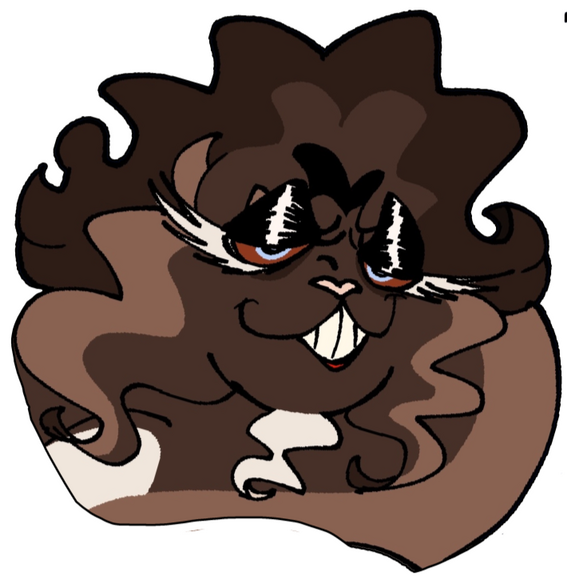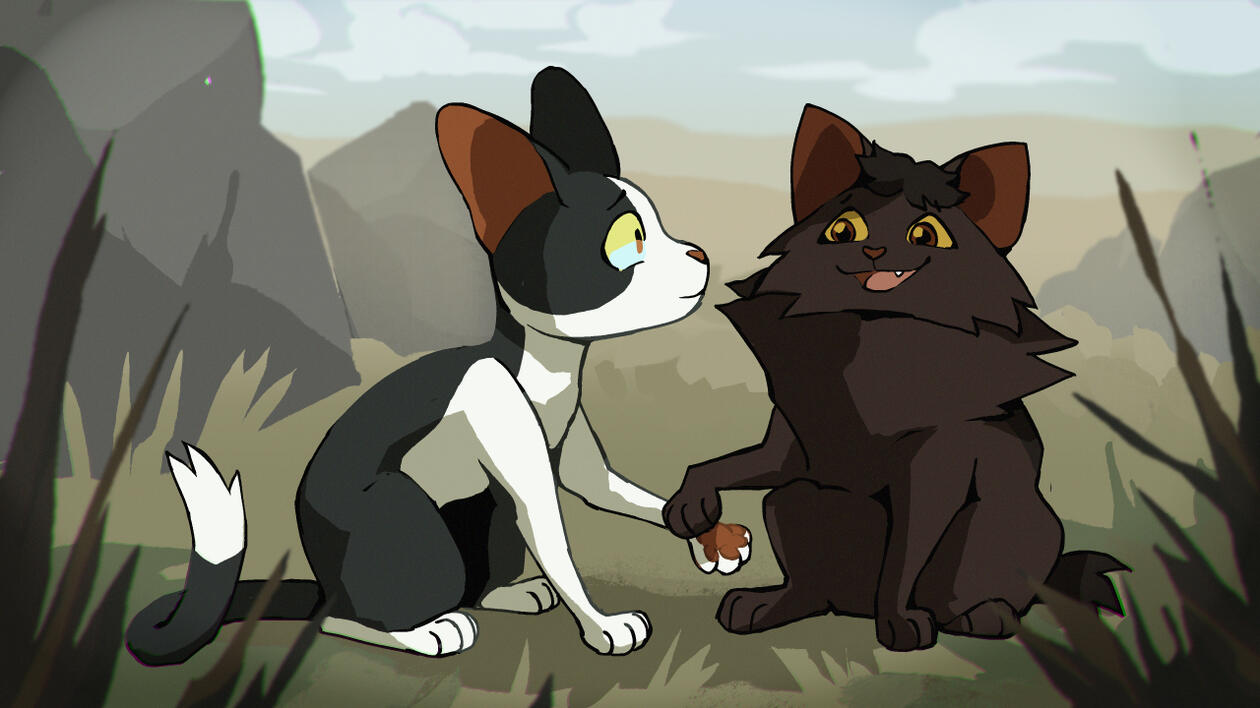
Windclan
Inhabiting the open moorlands near the lake, Windclan is known for its swiftness and independence. Their expansive, grassy territory is ideal for their exceptional running skills, allowing them to chase down prey and cover great distances with ease. The clan’s lean, agile warriors are built for speed, with coats that are less dense than those of other clans, suited to their wind-swept environment.Windclan’s camp is situated in a low, sheltered area surrounded by heather and tall grass, offering some protection from the harsh winds and occasional predators. Though their open terrain provides limited cover, it affords them a clear view of any approaching threats, maintaining their readiness. Their close-knit bonds and ability to traverse their vast territory make them resilient, as they skillfully navigate the challenges of their moorland home while remaining vigilant against any dangers that might arise.
Highranks
Leader

Hushstar
Hushstar is a petty, scornful, vengeful, bratty, and arrogant tom. He’s easily annoyed and doesn’t like being challenged, for he gets very frustrated and annoyed and sees it as a hit to his ego. He isn’t very fond of outsiders joining WindClan despite him being a former house cat, and though he’ll accept them into the clan he doesn’t treat them with much respect and will sometimes give them more difficult jobs. He’s not a very responsible leader but he does care about the well-being of WindClan and would never turn his back on them.
Deputy
Coming soon!
Medicine Cat
Coming soon!
Medcat Apprentice
Coming soon!
Allegiances
Tunnelers
LAVENDERSIGHT — hairless spotted brown she-cat with blind violet eyes, massive ears, and softer shades of white to her underbelly.FLAMERUNNER — sturdy brindled orange to red colored tom with heterochomatic green and yellow eyes.DENSESHADOW — stout dense-furred grayish-blue tom with dark stripes, wide paws, an odd tuft of fur on his head and fiery orange eyes.
Moor Runners
FLARESWIPE — slender sandy-furred tom with dark brown and black stripes, wide paws, and fiery reddish eyes.PALEFLOWER — beautiful greyish-cream tabby with white socks, white tail tip, and kind lavender eyes.RAVENCRY — small slender tabby she-cat with black rosetted markings that contrast beautifully against her blue-lilac eyes.SNAPCALLER — lynx-point fluffy-furred silver and ashen tom with vivid green eyes; known widely for their loyalty and cocky behavior.DARKESTWING — senior silver dark tabby, with battle scars along his body, he is not frail just soon to retire.QUIETSONG — thick-furred white feline with black patches. they have pale blue/green eyes. They smell of salt, rain, and wildflowers.OAKRUNNER — lean, sharp-faced tom with patchy black, brown, and cream fur and jagged scars along his flank.PRICKLEROCK — entirely white-furred cat with a slender build, green eyes, and messy fur. Sometimes their fur appears to have different colors such as light gray but that’s usually just due to the state of it.ANGELTALES — silky, lank tom with elegantly long hair, bang hanging over his forehead like a bundle of clingy lichen and hot pink eyes.
Windclan Queens
MORNINGBIRD — small cream and white she-cat with green eyes.
Kits
ARBUTUSKIT — small white tom-kit who's tail and hind quarters is a tortoiseshell coloring and he has green eyes.
Windclan Elders
LOTUSEYE — short, grey-white tom with a large claw mark on his left eye leaving it completely blind.

Lifestyle
Windclan cats have a distinct lifestyle shaped by their unique environment and the traditions of their clan. Here’s a detailed look at their way of life:
Territory and Shelter
Windclan is known for inhabiting the wide, open moorlands. Their territory is characterized by its expansive, grassy fields and gentle rolling hills, which provide them with a vast, unobstructed view of their surroundings. The open landscape allows them to spot potential threats and prey from a distance. The lack of dense forestation in their territory influences many aspects of their lifestyle.
Hunting and Diet
Windclan cats are skilled hunters, primarily focusing on prey that thrives in their open territory. Their diet mainly consists of small mammals such as rabbits, hares, and voles. The moorland environment offers ample opportunities for these skilled hunters to utilize their speed and agility. Tempeststar has perfected the hunt by providing different techniques of running down prey. This includes farmland phrases like:

| Come By | Instructs a warrior to go around or run down a hare in a clockwise direction. |
| Away | Instructs a warrior to go around or run down a hare in an anti-clockwise direction. |
| Divvet | Commands a warrior to make a sharp turn with a hare in the event it slows down. |
| Walk up | Encourages a patrol to approach prey, enemies, and a rival patrol. |
Adapting to Terrain
WindClan cats are particularly well-adapted to their open, windy environment. Their long legs and lean bodies are built for speed, which is crucial for both hunting and escaping from threats. Their fur is typically shorter compared to other clans, which helps them stay agile and prevent overheating during their swift sprints across the moors.Due to the expansive nature of their territory, WindClan cats spend a lot of time patrolling and marking their borders. The clan values a high level of vigilance and territory maintenance to ensure their safety and to ward off potential invaders. Especially since their camp is vulnerable to attack.
Values & Belief
Windclan warriors are known for their independence and pride. They often have a strong sense of self-reliance and are proud of their ability to thrive in the challenging moorland environment. Their resilience and ability to endure harsh weather conditions and limited shelter contribute to their reputation as one of the most hardy and self-sufficient clans.Young WindClan apprentices are trained to harness their natural speed and agility. They practice hunting techniques suited to their open territory and learn to navigate and patrol their extensive borders. Training emphasizes endurance, swift reflexes, and the ability to read the open landscape effectively.
Resources
Yarrow (Achillea millefolium)
Yarrow is a plant with feathery, fern-like leaves and flat-topped clusters of small, white or pink flowers. The plant has a strong, herbal scent and can grow up to 2 feet tall. Yarrow is used to induce vomiting in cases of poisoning and to stop bleeding from wounds. It has anti-inflammatory and astringent properties that make it effective for treating various injuries.Where to Find: Yarrow is commonly found in meadows, grasslands, and along roadsides. It thrives in well-drained soil and sunny conditions, often appearing in areas with minimal disturbance.
Lambs Ear (Stachys byzantina)
Lamb's Ear is a plant with soft, fuzzy, silvery-green leaves that resemble the ears of a lamb. It produces small, purple or pink flower spikes in late spring to summer. The plant has a pleasant, mild scent and is known for its soothing properties. The leaves can be used to treat minor wounds and skin irritations due to their antiseptic and soothing qualities.Where to Find: Lamb's Ear is commonly found in well-drained, sunny grasslands and rocky hillsides. It thrives in dry soil and can often be seen in garden beds or naturalized in open, sunny areas.
Plantain (Plantago major)
Plantain is a low-growing herb with broad, oval leaves and tall, slender flower spikes that produce small, greenish-brown flowers. The leaves are thick and ribbed, and the plant has a mild, earthy aroma. Plantain is known for its wound-healing properties and can be used to relieve insect bites, rashes, and minor cuts.Where to Find: Plantain grows abundantly in grasslands, meadows, and disturbed areas like roadsides and pastures. It prefers well-drained soil and can often be found in areas with moderate sun exposure.
Hawthorn (Crataegus monogyna)
Hawthorn is a shrub or small tree with thorny branches, green leaves, and clusters of small, white or pink flowers that bloom in spring. The plant produces red or black berries in late summer to fall. Hawthorn is known for its cardiovascular benefits and can be used to strengthen the heart and improve circulation.Where to Find: Hawthorn is often found in open grasslands, hedgerows, and hillsides. It prefers well-drained soil and can tolerate a range of sunlight conditions, from full sun to partial shade.
Lavender (Lavandula angustifolia)
Lavender is a fragrant herb with slender, silver-green leaves and tall spikes of small, tubular flowers that range in color from light purple to deep violet. The plant has a strong, soothing aroma and can grow up to 3 feet tall. Lavender is valued for its therapeutic benefits. It is commonly used to promote relaxation and alleviate stress, anxiety, and insomnia. This is also a less extreme herb in place of lanolin.Where to Find: Lavender thrives in well-drained, sunny locations and is commonly found in gardens, herb beds, and in cultivated fields. It prefers dry, sandy or loamy soil and is often grown in areas with a Mediterranean climate or similar conditions.
Lanolin (Lan Oleum)
Lanolin is a natural, waxy substance derived from the wool of sheep.It is a yellowish, greasy substance that has a slightly oily texture and a mild, earthy odor. Lanolin is widely used in Windclan as an adhesive coating for minor abrasions to skin. It is known for its ability to lock in moisture and create a barrier on the skin, which helps to prevent water loss and keep the skin hydrated. It is rich in fatty acids and cholesterol, which help maintain a wound's natural barrier against infection.Lanolin can offer benefits, however proper use and monitoring are key to ensuring that lanolin provides positive benefits without causing any adverse effects. It can actually burn or irritate cats with albinism, and those with skin sensitivity. Medicine cats use this sparingly.